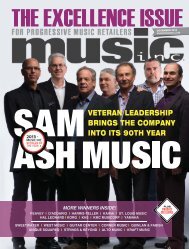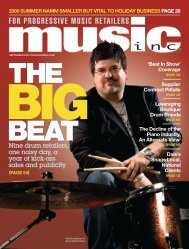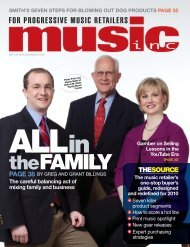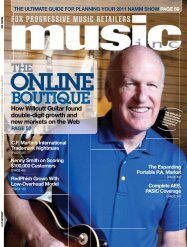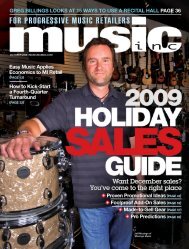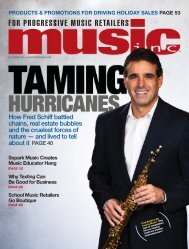VISIONARY - Music Inc. Magazine
VISIONARY - Music Inc. Magazine
VISIONARY - Music Inc. Magazine
Create successful ePaper yourself
Turn your PDF publications into a flip-book with our unique Google optimized e-Paper software.
a compelling offer. “We’ve got<br />
guitars” is not an offer. “Twentyfive<br />
years in business” is not an<br />
offer. “Quarter Pounders for 99<br />
cents” is an offer. “Free drinks for<br />
ladies” is an offer. “Zero-percent<br />
financing for five years” is an<br />
offer. Many of our ads fail to<br />
present an irresistible offer.<br />
The ad also has to be graphically<br />
appealing and emotionally<br />
engaging. Our competition<br />
isn’t other music dealers — it’s<br />
other advertisers. A Costco store<br />
generating $200K per day or a<br />
car dealer selling $1 million a<br />
month can spend $50,000 to<br />
produce great ads, commercials<br />
and even websites that are visually<br />
stimulating and emotionally<br />
memorable. Think about the tearful<br />
Native American who didn’t<br />
want you to litter. In our little<br />
industry, we’ve seen a few impressive<br />
display ads that probably<br />
would’ve been successful<br />
if they could’ve been repeated<br />
often enough to make a sufficient<br />
impression, but they were rare.<br />
Usually, our production values<br />
suck. And poorly produced ads<br />
probably do more harm than<br />
good, especially on TV.<br />
Most important — and this<br />
is where we typically crash<br />
and burn — an ad needs to<br />
create a sufficient number<br />
of impressions before it will<br />
move customers to action. Our<br />
small ad budgets just aren’t sufficient<br />
to reach an impression<br />
threshold necessary for success.<br />
And those impressions need to<br />
be delivered to people who fit our<br />
target demographic — provided,<br />
of course, that we know who our<br />
target demographic is and where<br />
to find them.<br />
Ironically, if we could spend<br />
enough to reach the impression<br />
threshold, most of us couldn’t<br />
handle the resulting traffic. A<br />
critical mass must be achieved,<br />
and half-measures won’t work.<br />
Fifty percent of the necessary<br />
expenditure might get you 10<br />
percent of the desired return,<br />
but 110 percent might double<br />
your return. Because of the<br />
impression-threshold barrier,<br />
it’s unlikely small and mediumsized<br />
businesses will ever have<br />
ad budgets large enough to make<br />
newspaper, radio, broadcast TV<br />
or magazine advertising pay.<br />
Timing is also crucial. There<br />
are times when ads will work<br />
and times when they won’t. (See<br />
sidebar below, right.) Advertising<br />
because business is slow is a<br />
pretty poor way to time ads, but<br />
it’s a great way to waste money.<br />
Bad timing kills more advertising<br />
efforts than any other cause,<br />
and it’s completely preventable.<br />
The Internet has affected timing<br />
more than any other aspect of<br />
advertising. People shop and seek<br />
online every hour of the day and<br />
night, and every day of the year.<br />
They buy plane tickets at 3 a.m.,<br />
and they buy underwear sitting<br />
at their desks at work. All the<br />
traditional rules used to predict<br />
weekly and seasonal shopping<br />
trends are obsolete. Thirty years<br />
ago, November and December<br />
accounted for 25 percent of our<br />
annual volume, as they had for<br />
generations. May and June were<br />
the slump. Today, the Christmas<br />
season is a blip, and May can be<br />
as good as any other month if a<br />
dealer promotes over the Memorial<br />
Day holiday and it rains.<br />
One vehicle that has evolved<br />
to our benefit is direct mail (to<br />
our own mailing lists). With<br />
many advertisers switching to<br />
electronic media, there’s less<br />
junk in our mailboxes and less<br />
competition for our customers’<br />
attention. E-mail boxes, though,<br />
are stuffed with junk.<br />
And finally, we can’t control<br />
what we don’t measure.<br />
When’s the last time any of us<br />
attempted to measure the effect<br />
of our advertising accurately and<br />
honestly? Probably never — because<br />
we lack the expertise and<br />
the tools. Ad expense as a percentage<br />
of sales is not a measurement.<br />
It’s a result. It doesn’t tell us the<br />
effectiveness of a particular activity.<br />
It just tells us how much we<br />
spent relative to sales that might<br />
have occurred anyway.<br />
CRITICAL QUESTIONS<br />
Buying advertising boils down<br />
to big guys versus small guys.<br />
Depending on the size of the market,<br />
your local newspaper or TV<br />
station may have annual sales<br />
greater than all but the 10 biggest<br />
music retailers and a few suppliers.<br />
These vendors are not your<br />
friends. They slice and dice their<br />
products, so the big advertisers<br />
get the cream and the little guys<br />
get the chaff. The big guys know<br />
how to buy, leaving the leftovers<br />
for us. The big guys know how<br />
to produce effective ads, when<br />
to run them and how to measure<br />
their effectiveness. We don’t.<br />
Every small advertiser should<br />
ask the following question before<br />
buying an ad: Will this expenditure<br />
generate enough revenue<br />
to justify the expense?<br />
Answers along the lines of, “We<br />
are raising awareness, generating<br />
goodwill, creating an image or<br />
planting seeds,” aren’t reasons —<br />
they’re excuses. Big corporations<br />
may be able to afford feel-good<br />
luxury ads, but small advertisers<br />
like us could never reach the<br />
threshold of impressions and frequency<br />
necessary to accomplish<br />
any of those lofty goals.<br />
A follow-up question could<br />
be, “What would happen if<br />
we did nothing?” Even if you<br />
don’t spend a dime on advertising,<br />
a certain number of customers<br />
will find you.<br />
Every hour of every day, your<br />
location and sign tell customers<br />
where you are and what you do.<br />
b Four Elements of Successful Ads<br />
1. The target. Who’s the intended subject? We use demographics to identify<br />
them and a media to deliver to them. It could be a mailing list, viewership of<br />
a TV program or channel, subscribers to a magazine or newspaper, Googlers<br />
of a particular word or phrase, or a hundred other mediums. It’s not enough to<br />
look at gross circulation or viewership metrics. If the medium isn’t reaching<br />
your demographic, it will be inefficient at best and ineffective at worst.<br />
2. The message. How good is the ad itself? If you watched the Super Bowl, you<br />
saw ads that cost millions. Do you remember them? Many magazines have ads<br />
with stunning, memorable visual images and some that don’t. The message matters.<br />
A common mistake is to spend too much money on buying time or space<br />
and not enough on production. We often make this mistake because the vendor<br />
throws in free production if we buy enough time. We get exactly what we pay for.<br />
3. The offer. Will the offer cause customers to take action? The reason goingout-of-business<br />
ads work, no matter how poorly executed, is because the offer<br />
is irresistible. If your message isn’t compelling, or if it doesn’t demand action,<br />
money’s being wasted. Really effective advertisers find a way to make their<br />
offer appealing. Research indicates that the word “free” is remarkably effective<br />
in ads. There are other effective words you can find with a little research.<br />
4. Timing. Get the first three perfect but miss the timing, and you lose! In<br />
our business, there are times that are hopeless — the week before Easter<br />
and the week after New Year’s. When I was young and people still cashed<br />
paychecks, we knew that when the 15th fell on a Friday everybody would<br />
get paid and the mortgage or rent would have already been covered. So,<br />
we placed ads on triple paydays, and they worked. A little common sense<br />
and research will guide advertisers to the proper ad timing. — G.B.<br />
JULY 2011 I MUSIC INC. I 41



